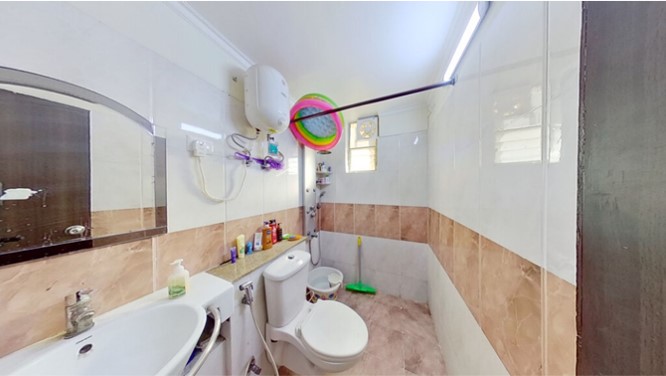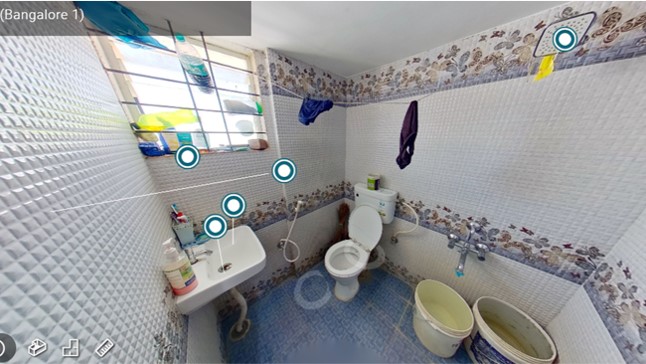<From Overseas Office> [India] World Residence Tour, Bathrooms in India.
- Release date: Dec 16, 2021
- 15163 Views
In addition, solid soaps are more widely used than shower gels in India, and you can often find value packs of several soaps in retail outlets.

The bathroom of the condo. The tank you can see at the top is the “Giza”(electric water heater)
Source: Intage Consumer Database Consumer Life Panorama
Source: Intage Consumer Database Consumer Life Panorama

Bathroom
In many Indian homes, the shower cubicle and toilet are adjacent to each other and there is no partition between them, so when you take a shower, the whole bathroom gets soaked. However, as the bathroom floor is made of stone and there are no steps, it is easy to dry off when wet, and when it comes to cleaning, there is the advantage of being able to clean the wash area, toilet and shower all at once. When I clean the bathroom at home, I also use the hand shower on the toilet to wash off all the detergent after cleaning the floor. I notice that many homes do not have storage cabinets in the bathroom, probably because they assume that water will be splashed when showering or washing up on the floor. Even in luxury condominiums, where storage shelves are not available, people use washbasins, window sashes and small spaces behind toilets as storage areas for soap, shampoo and detergent. Since many households keep bottles and other items as they are, it would be acceptable if storage accessories similar to those sold in 100-yen stores in Japan could be provided at a low price.In high-rise flats in India, there is a space outside the bathroom called a ventilating shaft, which runs up and down the building, preventing wind from entering the building, which reduces the capacity of the ventilating fan in high-rise flats, and also serves to maintain the design of the building so that the fan is not visible from the outside. In some cases, the space is also used for gas and other utilities, as it is the shortest possible distance for water pipes to be installed and, in the event of a breakdown, the space can be easily repaired.

A condominium in Mumbai. The red area is the shaft. (Source: photo by the author)
Bathroom in the slum
So far we have looked at bathrooms in the homes of the wealthy, but I would like to show you what it is like in the slums. I have visited about 20 houses in the slums of Mumbai, and many of them do not have bathrooms, but use shared toilets. In the slums where there was a well-functioning management association, they collected a few rupees for the use of the common toilets at the entrance to keep them clean and maintained. As a side note, there are many different standards of living in slums. In Mumbai, where rents are very high, especially in the city centre, there are young businessmen who choose to live in slums for the convenience of commuting, and families who work for major companies but live in slums with their parents. In such homes, there is a proper bathroom in the home, and some have appliances such as a large refrigerator and a front door washing machine, which one would not expect from the word “slum”. I haven’t had the opportunity to visit the slum due to the Covid-19 pandemic, but I always hope to return there to understand “how it is now” when things have settled down.(Left) Shared toilet in a slum
(Middle) A relatively affluent house in a slum with a separate bathroom. Water supply is also provided.
(Right) A house in a slum where all water facilities (dishwashing, hand washing, bathing) are shared, with buckets of water brought in from the shared tap. (Source: photo by the author)
(Middle) A relatively affluent house in a slum with a separate bathroom. Water supply is also provided.
(Right) A house in a slum where all water facilities (dishwashing, hand washing, bathing) are shared, with buckets of water brought in from the shared tap. (Source: photo by the author)
Introduction of Consumer Life Panorama
Consumer Life Panorama is a web-based database from Intage that allows you to see the real living conditions of consumers in Japan and overseas. You can view 360-degree images of the living environments of consumers in various countries, and see their daily routines, flow lines, and digital lives.Some of the photos in this article are taken from the database. This service can be used when you want to observe the living environment of overseas consumers at hand, without the need for customized surveys.
The Consumer Life Panorama demo site can be found here
For an overview of Consumer Life Panorama here
-

Author profile
Ryosuke Nakamura
He has been stationed in India for three years, spending one year each in Mumbai, Delhi and Bangalore.He is an expert on India, having been exposed to the customs and culture of the whole country through his projects.He remains in India during the lockdown to provide clients with first-hand information about the country.
 Global Market Surfer
Global Market Surfer CLP
CLP